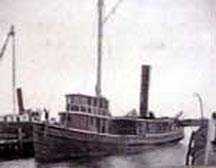SS Commodore
 SS Commodore at dock | |
| Career | |
|---|---|
| Launched: | 1882 |
| Fate: | Wrecked 1897 |
| General characteristics | |
| Tonnage: | 178 tons |
| Length: | 122.5 ft (37.3 m) |
| Beam: | 21 ft (6.4 m) |
| Draft: | 9 ft (2.7 m) |
| Installed power: | Coal-fired |
SS Commodore was an American steamboat that shipwrecked off the coast of Florida on 2 January 1897, while en route to Cuba. The event was immortalized when passenger and author Stephen Crane, who was traveling as a war correspondent for the Bacheller-Johnson syndicate, wrote the classic short story "The Open Boat" about his experience. Crane and three other men, including the ship's captain, Edward Murphy, were stranded in a 10-foot (3.0 m) dinghy for nearly thirty hours near the Mosquito Inlet Lighthouse (today's Ponce de Leon Inlet Light) before they were able to reach shore; all but one of the men survived.
During 2002-2004 three seasons of archaeological investigation[1] were begun in order to archaeologically document the exposed remains and to definitively identify the vessel. The results of this fieldwork were eventually incorporated into a Master's Thesis[2] produced by Kimberly Eslinger Faulk,[3] then a graduate student at East Carolina University's Maritime Studies Program. For two weeks in May 2002, Faulk, a crew of technical divers from the Cambrian Foundation, representatives of PILHA and videographer Rick Allen from Nautilus Productions completed the first archaeological survey of the wreck site. In keeping with the Light House’s mission of protecting the wreck site and better interpreting its importance to the people of Ponce Inlet and Daytona Beach, Florida project parameters were laid out for a professional archaeological survey of the site. Nautilus Productions provided video mosaic services, site documentation and recorded survey and diving activities on site.[4] Later in 2004 scientists from the Lighthouse Archaeological Maritime Program (LAMP) at the St. Augustine Lighthouse & Museum offered their assistance to PILPA in their ongoing investigation of the vessel remains and visited the shipwreck site for a series of dives on April 7, 2004. The recording of the engine remains by LAMP divers resulted in measurements of a 26-inch bore and a 30-inch stroke. These dimensions are a perfect match with the schematics for the single-expansion steam engine built by the Neafie & Levy yard in Philadelphia as listed in the 1882 survey produced when Commodore was first registered. This data and the accumulated evidence finally substantiated the identification of this sunken vessel as Commodore beyond a reasonable doubt.
References
- Notes
- ↑ "The Shipwreck, Discovery, and Investigation of the SS Commodore". St Augustine Lighthouse. Retrieved 2015-03-17.
- ↑ Eslinger, Kimberly Lane (2005). And All the Men Knew the Colors of the Sea... : Historical and Archaeological Investigation of the SS Commodore's Remains, Ponce Inlet, Florida (Thesis).
- ↑ Faulk, Kimberly L. (14 December 2010). "Deepwater Archaeology in Oil and Gas". Museum of Underwater Archaeology.
- ↑ "SS Commodore Shipwreck Project". Nautilus Productions.
- Bibliography
- Davis, Linda H. (1998). Badge of Courage: The Life of Stephan Crane. New York: Mifflin. ISBN 0-89919-934-8.
- McCarthy, Kevin M.; Trotter, William L. (1992). "Commodore, 1897". Thirty Florida Shipwrecks. Pineapple Press Inc. p. 77. ISBN 1-56164-007-7.
Coordinates: 29°12.23′N 80°46.44′W / 29.20383°N 80.77400°W